Canning Tomato Sauce Step by Step
This post may contain affiliate links, view our disclosure policy for details.
Canning tomato sauce is on every homesteader’s to-do list. There is just no comparison between the taste of homemade tomato sauce, made with delicious summer tomatoes, and the one we can get at the store. And… It might be the best way to preserve tomatoes since there are so many ways to use tomato sauce. Let’s learn how to can tomato sauce at home.
I don’t know if there is anything better than a true summer tomato… whether it’s one you grew yourself in your garden or one that you picked up at the farmer’s market. Red, warm, and juicy… I think that tomatoes, more than any fruit or vegetable, bring people out to the garden or to the farmer’s market during the growing season.
And if you ever tasted a true homegrown summer tomato I bet the first thing you thought about was how to preserve the taste so you don’t have to go without it. That’s where canning tomato sauce comes in! It’s a wonderful way to preserve the summer harvest and it gives you the option to use summer tomatoes in so many ways even after the growing season is long gone.
Canning Tomato Sauce…
If you are a gardener and you grow your own tomatoes, you probably know that it takes a lot of work. We start tomato seeds indoors, then transplant them to the garden (here is a video on how to do that), they need a good support system, a lot of feeding and pruning, and so on… So aside from preserving the taste of summer tomatoes, you probably want to preserve your harvest simply because you worked so hard for it.
Every year, I can stewed tomatoes, crushed tomatoes, cherry tomatoes, and tomato sauce from the tomatoes that I harvest from my garden (even though this batch was made from too-ripe tomatoes that I came by at the farmer’s market for a next to nothing price and just couldn’t resist!). Even though there are many ways to can tomatoes, I have to say that canning tomato sauce is always the way that I turn to first simply because I can use tomato sauce later in so so many ways.
What Kind of Tomatoes Are Good for Canning Tomato Sauce?
Paste tomatoes have less water in them and therefore are better for canning tomato sauce simply because it takes less time to cook the sauce. They are thick and meaty. Some of the famous paste tomato varieties are Amish Paste and Roma. Make sure to choose very ripe tomatoes for canning.
However, you can can any type of tomato and you can even make a mix of a few varieties. The flavor will change obviously and the cooking time might change depending on the water content of your tomatoes but you can use this tutorial to can any variety of tomatoes.
The important thing here is that you want to use very ripe tomatoes! If you grow your own tomatoes, make sure to pick them at the Green Mature Stage and let them ripen indoors. Also, if you grow your own tomatoes and can’t can them right away or you need to wait until enough of them are ready for canning, remember that you can always freeze tomatoes and can them later, it’s literally the trick that saved my summer sanity!
Ingredients…
- Tomatoes – again, very ripe tomatoes preferably canning tomatoes like Amish Paste or Roma (but any kind can be made into sauce and canned). I used 26 pounds of tomatoes here which is what fits in my large stock pot. I’m recommending that you don’t process more than 25 pounds at the time… It gets a bit too much to handle. 25 pounds of medium to large tomatoes should yield about 7 quart jars of tomato sauce (or 14 pints).
- Seasonings – note that you can season your tomato sauce as you cook it with salt, black pepper, garlic powder, and so on… I usually choose to leave my tomato sauce plain since whatever dish I’m gonna use it in later is going to be seasoned anyway.
- Bottled lemon juice – in order to safely process the tomato sauce in the water bath canner, we want to increase its acidity just a bit. To get that done, we’ll use two tablespoons of bottled lemon juice (not fresh lemon juice! We use bottled lemon juice because it’s stable and its acidity is known) per quart jar or one tablespoon per pint jar. The acidity of the bottled lemon juice will prevent the growth of C. Botulinum bacteria; the bacteria that causes Botulism.
Some say that the lemon juice changes the taste of the tomato sauce, I personally don’t notice a change in taste so I use bottled lemon juice. But if you are concerned about the change in taste you can use citric acid (instead of the bottled lemon juice) which does not affect the taste at all. Add 1/2 teaspoon of citric acid to each quart jar or 1/4 of a teaspoon to each pint jar. Bottled lemon juice is easier to come by so that’s what I usually use.
Kitchen Tools…
- Large stock pot that can fit all of the tomatoes that you are going to process.
- Slotted spoon
- Large mixing bowl
- Food strainer is optional if you want to not only remove the skin of the tomatoes but also the seeds. Some people like running their tomatoes through it but I don’t. I’ll show you how I peel my tomatoes but I don’t mind the seeds in my sauce.
- Knife
- Cutting board
- Wooden spoon
- Immersion blender
- Measuring spoon
- Quart or pint jars
- Ladle
- Canning utensils
- Paper towel
- Water bath canner
How to Can Tomato Sauce…
Step 1 – prep the tomatoes. Wash the tomatoes well and core them (I removed the core of the tomatoes by inserting a sharp knife in the top of each tomato at an angle and cutting in a circular motion), then, cut a little X at the bottom of the tomato to help the skin come off easily.
Bring a pot of water to a boil, add the tomatoes in batches (not too many of them at a time), and let them cook for two minutes or so in the boiling water…
Use the slotted spoon to take the tomatoes out of the boiling water and set them in a large mixing bowl. Place the mixing bowl in the sink and run cold water on the tomatoes to cool them down so you can handle them.
Grab one tomato at a time and peel it. The skins should come off very easily. You can save those and dry them. If you have a food dehydrator it’s easy to dump them in there but you can also dry them in the oven. Some people eat them like chips and some grind the dry skins to make tomato powder which you then can add to soups or many other dishes as a seasoning.
A couple of notes here before we move on…
- I will admit that more than once I didn’t bother removing the tomato skin at all. I just threw the tomatoes in the pot and cooked them and mashed them with the immersion blender like you’ll see me doing below. The tiny pieces of skin didn’t bother me. It’s not ideal, but possible.
- Another thing I’ve learned is that if you want to skip the hot-water-to-remove-the-skins step, you can simply throw your tomatoes in the freezer for a few days. When you thaw them, the skins will just come off easily.
- Lastly, I’ve learned from one of the fabulous ladies that comment below that there is a very cool machine called the VICTORIO Deluxe Food Strainer that removes the seeds and the skin and makes a sauce of your tomatoes all at once. Then you just have to cook it however you want and can.
Once the skins are gone, half or quarter the tomatoes and add them to a large stockpot for cooking the sauce.
Step 2 – cook the tomato sauce. Set the stockpot on the stovetop, turn the heat to medium-high and bring the tomatoes to a boil. Turn the heat down a bit to keep the tomatoes gently bubbling for the rest of the cooking time. Remember to stir frequently.
After about an hour of cooking, when the tomatoes are soft, use the immersion blender to blend the tomatoes into a smooth sauce (or you can leave it a bit chunky if you’d like).
How long it will take to cook your tomato sauce depends on the water content of the tomatoes that you started with and how thick you like your tomato sauce. It took almost three hours for my sauce to reach the thickness I wanted it to. You can choose to season it a little bit with salt and pepper, and maybe some garlic powder or oregano, but I decided to just leave it unseasoned so I can season it when I use it.
Step 3 – prep for canning tomato sauce. Fill the water bath canner with enough water to cover the jars that you are going to use by at least an inch. Set the canner on the stovetop, turn the heat to high, and bring the water to a boil. Wash the jars and lids in hot water and dish soap (since we are going to process the tomato sauce for more than 10 minutes in the water bath canner, there is no need to sanitize the jars and lids).
Step 4 – fill the jars. Add two tablespoons of bottled lemon juice to each quart jar (or one to each pint jar), then use the ladle and the canning funnel to fill the jars with the tomato sauce leaving about 1/2 inch of headspace.
Next, use the bubble remover to remove bubbles by moving it along the inside of the jar. Then, clean the rim of each jar with a damp paper towel…
Before centering the lid and closing the jar with the band finger-tight.
Step 6 – process the tomato sauce. Place the jars on the rack of the canner and lower the rack into the boiling water. Cover the canner and process pint jars for 35 minutes and quart jars for 40 minutes in the boiling water. Remember to adjust processing time according to the table below if you live above 1000 feet in elevation.
When the processing time is up, turn the stovetop off and uncover the canner. Let the jars stay in the hot water for 5 more minutes before you remove them. Use the jar lifter to remove them from the canner and set them on a kitchen towel on the counter to cool completely (8-12 hours).
Storing Canned Tomato Sauce…
Check that your jars have sealed by pressing the center of each lid. If there is no movement there it means that the jar is sealed and ready for storage. I usually wipe the jars and remove the band (it tends to rust and make it hard to open the jar down the road, it’s easier to monitor what’s happening in the jar without the band in the way, and I can reuse it) before storing the jars in a cool and dark place (a pantry, kitchen cabinet, root cellar…).
Canned tomato sauce will last on the shelf for up to 18 months. I find that after that it starts losing its taste.
Using Homemade Canned Tomato Sauce…
- To make marinara sauce – we eat spaghetti at least once a month. I use this canned tomato sauce to make marinara sauce for the pasta and we usually use the leftovers for a homemade pizza.
- Add to chili or soups – our favorite is this Southwest chicken chili (or leftover turkey from Thanksgiving!), or the Pioneer Woman beef and bean chili. I use this tomato sauce in both of those.
- Tomato soup – I mean… Nothing is better than tomato soup made with summer tomatoes in the dead of winter! This recipe is a favorite.
- Add it to shakes – if you are into vegetable shakes you can use this tomato sauce in your shakes, or you can strain it and just drink the tomato juice, or heck… Use it to make a tall glass of Bloody Mary!
I hope that this tutorial was helpful! Making and canning tomato sauce is not complicated or hard but it does require a bit of work. It’s all worth it, though! Homemade canned tomato sauce is so much better than any tomato sauce you’ve tried before. I guarantee it.
More Canning Tutorials…
- How to Can Beets
- Canning Hot Peppers
- Canning Carrots Step By Step
- How to Can Milk
- How to Can Meat
- Canning Roasted Red Peppers

Canning Tomato Sauce
How to make a simple tomato sauce and canning tomato sauce instructions.
Ingredients
- 26 lb Ripe tomatoes
- 14 tablespoons of bottled lemon juice
Instructions
- Prep the tomatoes: wash and core the tomatoes. Cut a small X at the bottom of each tomato.
Bring a large pot of water to a boil. Add the tomatoes in batches and let them cook for two minutes. With a large spoon, transfer the tomatoes to a bowl. Set the bowl in the sink and run cold water over the tomatoes for a couple of minutes to cool them.
Skin the tomatoes and quarter them. Place them in a large stockpot. - Cook the tomato sauce: bring the pot to a boil then lower the heat to medium so the tomato sauce is bubbling gently for the rest of the cooking. Don't forget to stir frequently.
After about an hour, puree the tomatoes using a stick blender or a food mill.
When the sauce reaches your desired thickness (it took me a total of about 3 hours) it's ready. If you'd like, you can season your sauce with salt, pepper, garlic powder, and so on. I usually leave it unseasoned. - Prep for canning: Fill the water bath canner with enough water to cover the jars by about an inch. Set it on the stovetop and turn the heat to high. Bring the water in the canner to a boil.
Wash the jars, lids, and bands well in hot water and dish soap and set aside. Since we are going to process the tomato sauce in the water bath for more than 10 minutes, there is no need to sanitize the jars. - Canning tomato sauce: add two tablespoons of bottled lemon juice to each quart jar (or one tablespoon to each pint), use a ladle and the canning funnel to fill the jar with tomato sauce leaving about 1/2 inch of headspace.
Use the bubble remover to remove air bubble by scraping it along the inside of the jar. Use a damp paper towel to clean the rim of the jar before centering the lid and closing it with the band. - Process the jars of tomato sauce: place the jars on the rack of the canner and lower the jars into the boiling water. Cover the canner and process pint jars for 35 minutes and quart jars for 40 minutes (if you live above 1000 feet in elevation you'll have to adjust processing time. The adjustment table is in the notes below).
Once processing time is up, turn the heat off and uncover the canner. Let the jars stay in the hot water for 5 minutes before removing them. Use the jar lifters to remove the jars from the canner and set them on a kitchen towel on the counter to cool completely (8-12 hours) before storing them. - Storing the tomato sauce: wipe the jars, remove the bands (cause they rust and make it hard to open the jar down the road), and store in a cool dark place like a pantry or a kitchen cabinet for up to 18 months.
Notes
- You can use this process to can any kind of tomatoes but the best kind is canning tomatoes like Amish Paste or Rome since they are less juicy and it takes less time to cook the sauce.
- Some people like to run their sauce through a food strainer to get rid of the seeds. You can do that after you boil the tomatoes (the strainer will remove both the skin and the seeds. There is a link to a strainer in the post under "Kitchen Tools"). I personally don't mind the seeds.
- Some people say that bottled lemon juice changes the flavor of the tomato sauce. We use bottled lemon juice because we have to add acidity to safely can tomato sauce and the acidity in bottled lemon juice is known and stable. I don't feel that it changes the flavor, however, if you are worried about that you can use citric acid powder instead of the bottled lemon juice. Add 1/2 teaspoon to a quart jar or 1/4 of a teaspoon to a pint jar.
- If you live above 1000 feet in elevation, remember to adjust processing time according to the table below...

Nutrition Information:
Yield: 7 Serving Size: 1Amount Per Serving: Calories: 308Total Fat: 3gSaturated Fat: 0gTrans Fat: 0gUnsaturated Fat: 2gCholesterol: 0mgSodium: 92mgCarbohydrates: 67gFiber: 20gSugar: 45gProtein: 15g

Hi! I’m Lady Lee. I help homesteaders simplify their homesteading journey while still producing a ton of food! I am a single mother of four, I was born in Israel and raised in an agricultural commune called a Kibbutz. Now I homestead in central NC.


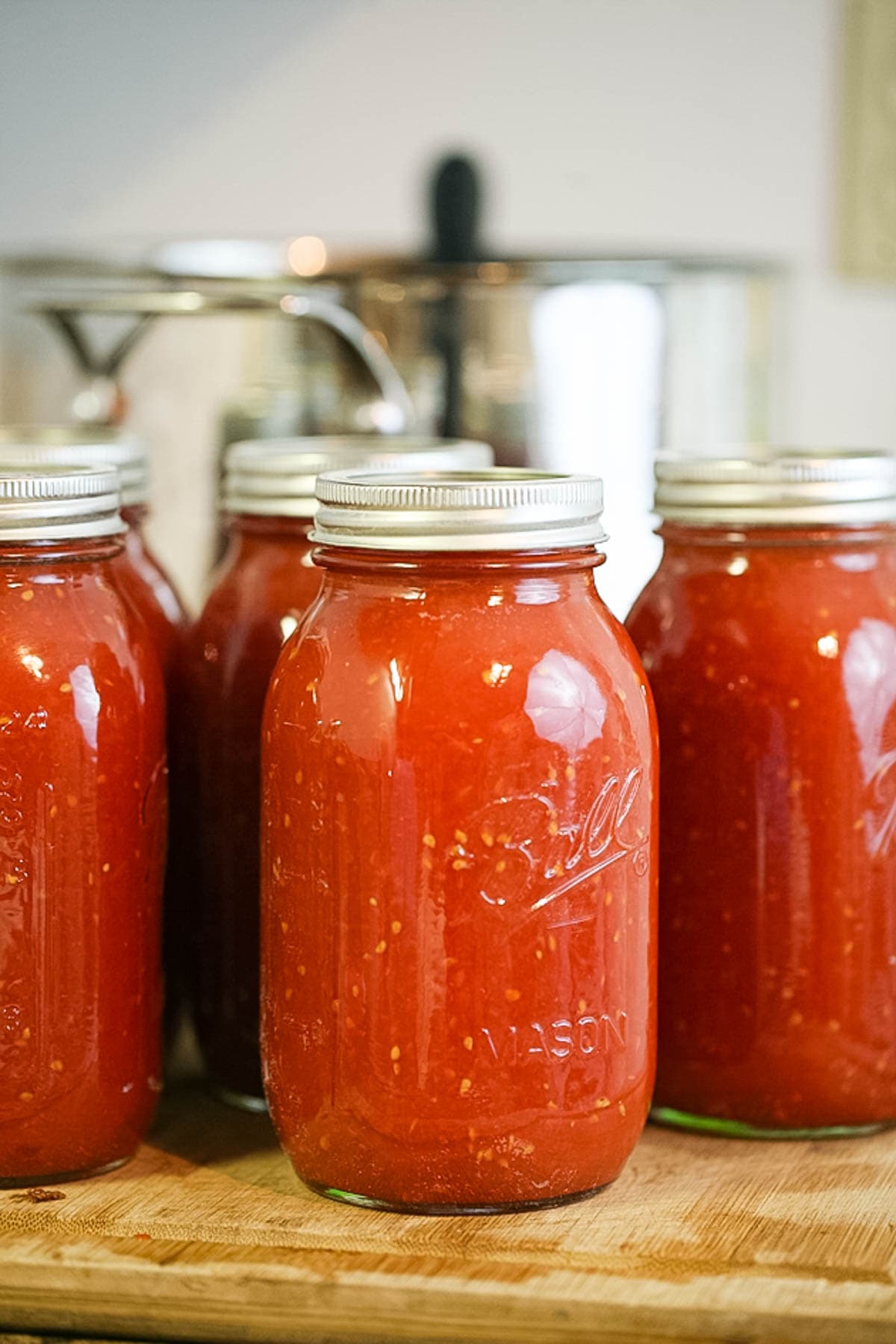




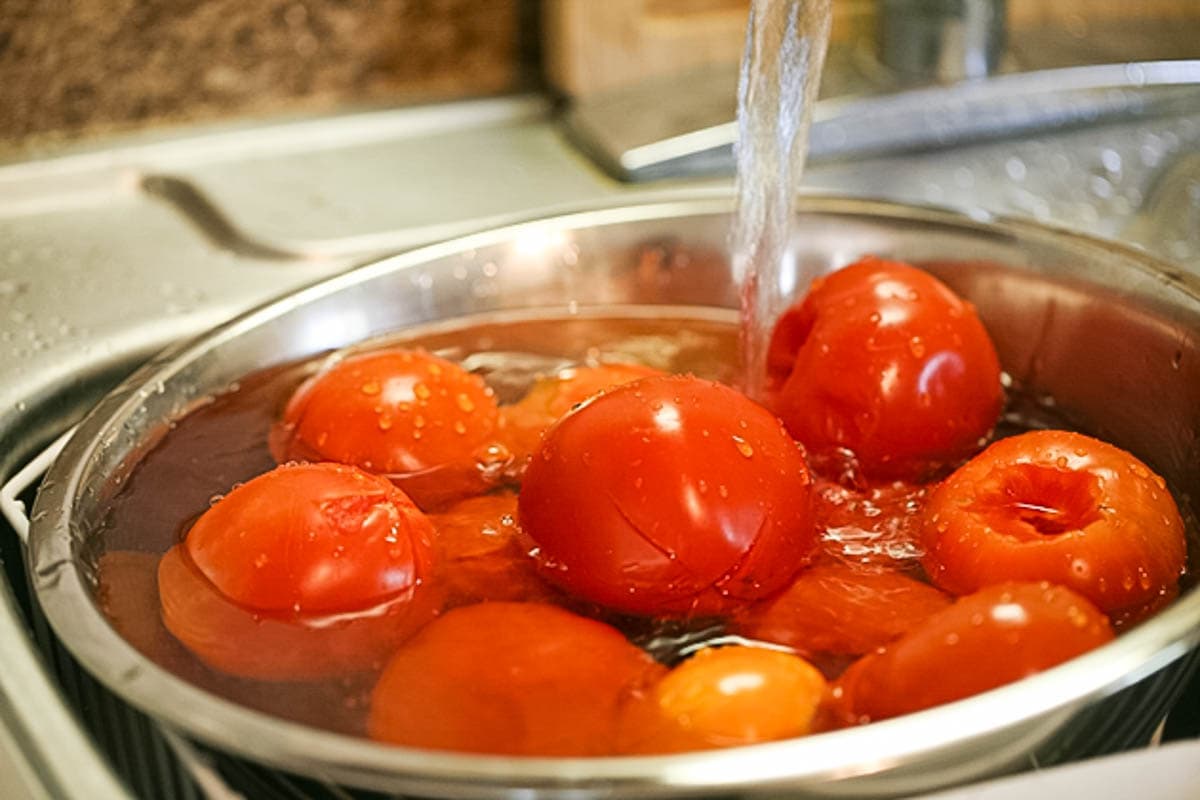








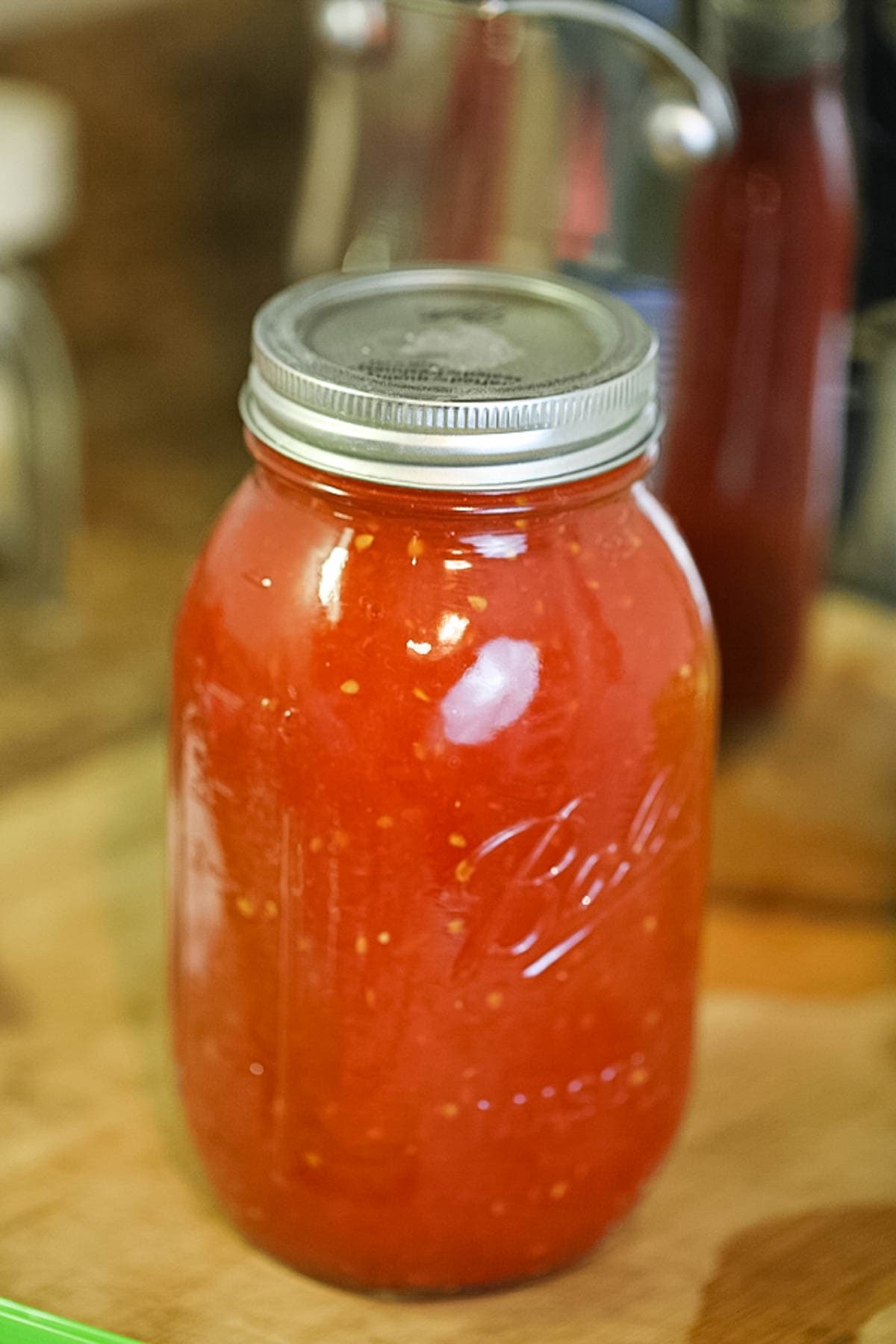


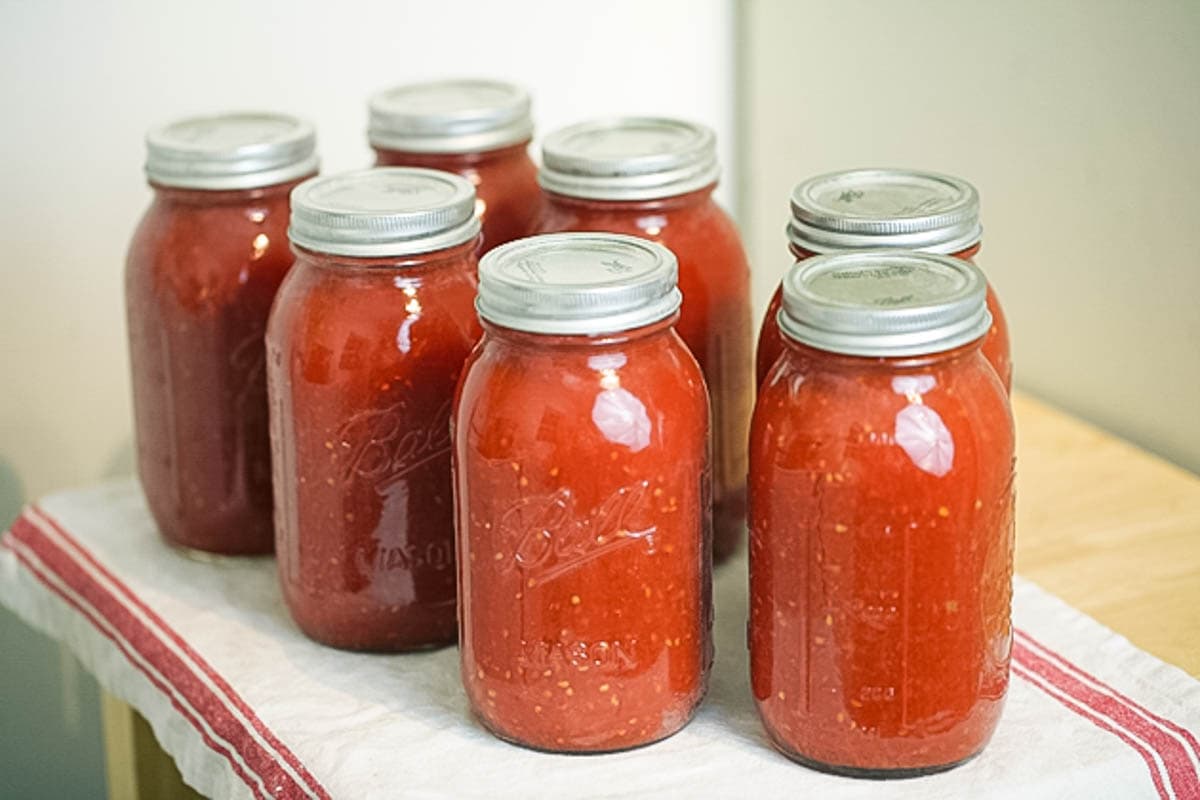
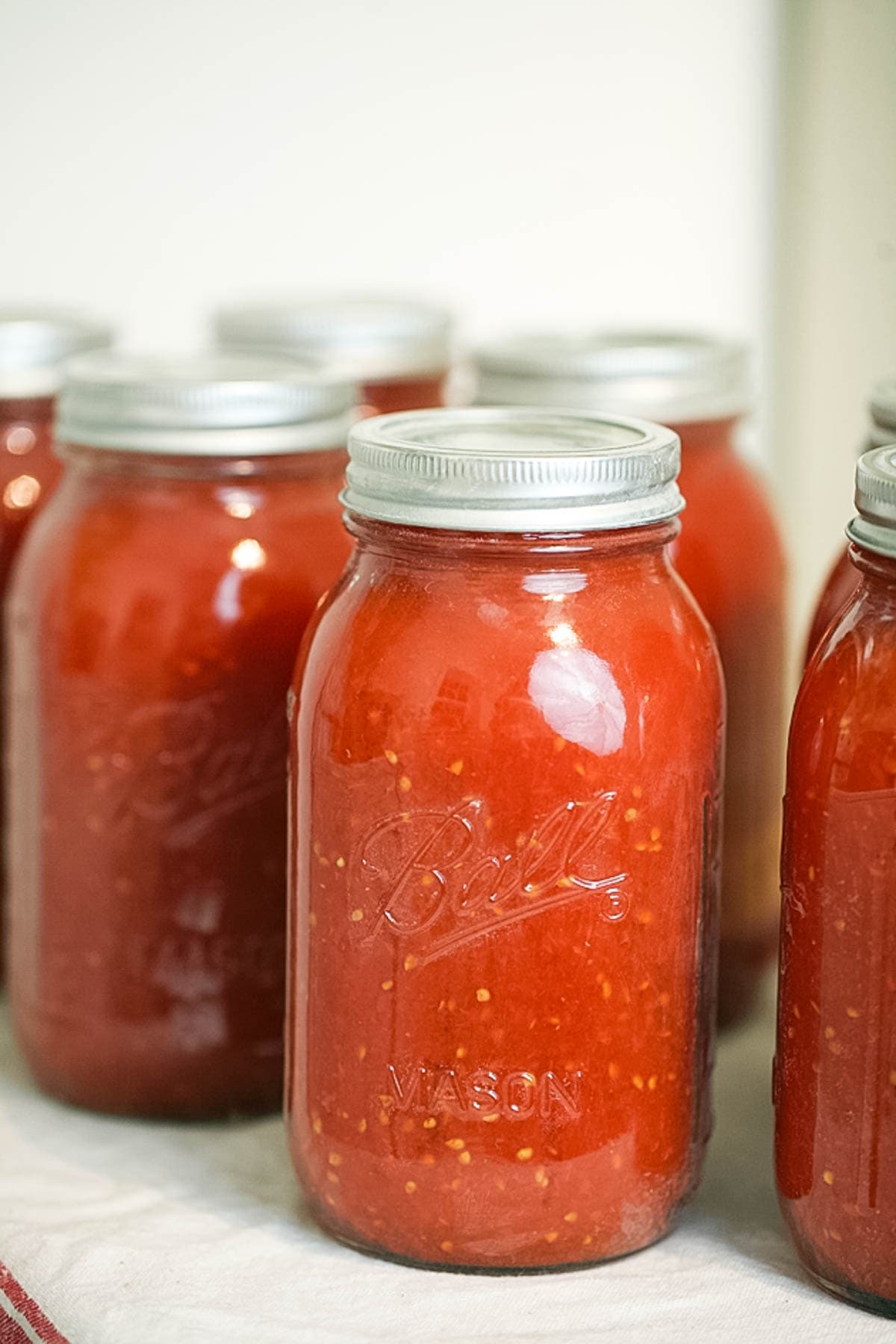






I’m a little confused do you add the lemon juice to the bottom of the jar first and then add the tomato sauce or do you put the lemon juice on the very top before sealing?
It doesn’t matter. I add it first usually.
Hi. If I add salt, pepper and garlic powder would I need to pressure can? This is my first time making tomato sauce. Thanks
I don’t think so. If it’s only seasonings that you are adding it shouldn’t change the acidity too much. You should be good to water bath.
Hello
Is it possible to make tomato sauce with veggies like garlic onion cook and just put it in sterilized jars and let seal. I’m asking because a friend brought me some sauce she made and never water bathed them.. I always thought for safety (botulism) that was necessary.
It’s controversial… Read my “canning stewed tomato” tutorial. Some say that the acidity of the tomatoes is enough to not need to pressure can them if you add other vegetables. Some say that if you add other vegetables you have to pressure can because it changes the acidity too much… It’s up to you to decide what you want to do.
Thank you for such a wonderful and detailed explanation. It has been years since I was able to can tomatoes and I wanted to make sure I didn’t miss anything. Your notes were so detailed that even a newbie can follow them. Thanks again!!!!
Thanks for the feedback! I’m so glad you liked it.
If for some reason, I made a canning approved spaghetti sauce, there is no seal after processing how long do I have to reprocess the sauce? Is there a specific method?
If you made spaghetti sauce I am guessing that you used other vegetables like onions maybe or seasonings, garlic and maybe other things. These other ingredients interfere with the acidity of the tomatoes so I’d suggest that you pressure can it. I have a “how to can stewed tomatoes” tutorial here on the blog. You can follow the instructions there to can spaghetti sauce.
Hi! When you say that you remove the bands, are you saying that you remove the metal to ring that screws the lid to the jar? How does this not open the jar and release the seal? Or does the suction created during the process keep the lid air tight? Last question! (Sorry, I have OCD and paranoia with food safety). Are there ways to prevent rust building up in the bands? Or could just replacing them with a thoroughly sterile and dried set be okay? Thanks for the great step by step instructions. I’m really trying to break my mindset and anxieties about food prep and this is a great starter project for me. 🙂
No problem! I understand that it can be a little stressful to eat food that has been sitting for a year 🙂
When we go through the water bath canning process the lid gets sealed to the rim of the jar and a vacuum occurs. During the processing, the job of the metal ring (which is also called a band) is simply to hold the lid in place so the rubber seal is touching the rim.
Once the jar seals there is no reason to keep the ring there.
Removing the ring should actually make you feel better! Rust but also other stuff like dust or whatever can accumulate under the ring if it stays in place. Also, sometimes, jars lose their seal as they sit on the shelf. When the ring is removed, you can easily observe what is happening in the jar. Usually, if mold start forming, it forms on top of the food. When the ring is not in the way, it’s easy to spot.
Yes, you can replace the wet ring with a clean, dry one, but really, everything stays much cleaner and easier to manage if there is no ring in the way.
I hope this helps!
I have a cold press extractor juicer that also comes with a screen for making smoothies instead of juice. I’ll core and quarter about 3 to 5 pounds of tomatoes throw in a carrot one stock of celery, a couple cloves of garlic and some basil covered in low heat until the vegetables become somewhat softened.
I let that cool and when finishedI run it through the juice extractor using the smoothie filter instead of the juice filter. It comes out nearly perfect. Actually it comes out slightly thin. What I do is put the the sauce on the cooktop at the very lowest setting I can leave it and let it simply slowly evaporate for 4 to 5 hours until the consistency is perfect. Using very little heat preserves the flavor of the tomatoes that I harvest from my own garden. The juicer does a nice job filtering out some of the skins and some of the seeds but not too much. The juicer does not produce that much pulp. Again, it leaves a perfect consistency. The ingredients sound very simple with my mother my grandmother my aunts are all Florentines and that’s their recipe and would make what they call their Pomarola sauce. Very simple very tasty. I still have my mothers passarola, but that was a lot of work.
This does sound good. I’m just not sure that you’d be able to process it in the water bath canner because the other vegetables change the acidity. I’d can it like I can stewed tomatoes… In the pressure canner. I add pretty much the same other veggies that you do. Thanks for sharing this!
Thanks for the recipe.
You are welcome!
Nice post
I would love to put up half pints. Do you know the water bath processing time? And how much lemon juice – half a tablespoon?
Process half pint jars the same time as pints, so 35 minutes. And yes, half a tablespoon of lemon juice to a half pint jar should work fine.
What if I added baking soda to the tomato sauce while cooking it down to reduce the acidity? Do I need to increase the amount of lemon juice in the mason jars?
Thx
Why do you need to reduce the acidity? If it’s for flavor then do that after you open the jar to cook with it. The reason that we can waterbath can tomato sauce is because it’s acid so it’s important not to change that.
I followed the recipe, however I put the filled jars in pot with 2-3 inches of boiling water , I did not cover the pint jars with hot water ! However I did cook bottle jars for 50 minutes. I am not sure I got a vacuum.
If you press on the center of the lid and it doesn’t move it means that the jars are sealed. But you do have to make sure that they are covered with at least an inch of water to properly water bath them.
Can you use a food processor to chop up the tomatoes before cooking instead of the blender?
Definitely. No problem with that.